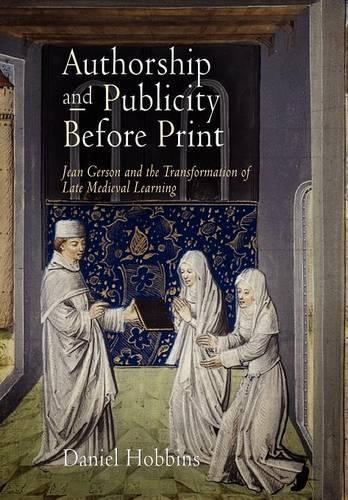Awards
- Winner of Awarded the 2009 Jacques Barzun Prize for Cultural History from the American Philosophical Society.
- Winner of Winner of the 2010 publication award from the Ohio Academy of History.
Overview
Widely recognized by contemporaries as the most powerful theologian of his generation, Jean Gerson (1363-1429) dominated the stage of western Europe during a time of plague, fratricidal war, and religious schism. Yet modern scholarship has struggled to define Gerson's place in history, even as it searches for a compelling narrative to tell the story of his era. Daniel Hobbins argues for a new understanding of Gerson as a man of letters actively managing the publication of his works in a period of rapid expansion in written culture. More broadly, Hobbins casts Gerson as a mirror of the complex cultural and intellectual shifts of the fourteenth and fifteenth centuries. In contrast to earlier theologians, Gerson took a more humanist approach to reading and to authorship. He distributed his works, both Latin and French, to a more diverse medieval public. And he succeeded in reaching a truly international audience of readers within his lifetime. Through such efforts, Gerson effectively embodies the aspirations of a generation of writers and intellectuals. Removed from the narrow confines of late scholastic theology and placed into a broad interdisciplinary context, his writings open a window onto the fascinating landscape of fifteenth-century Europe. The picture of late medieval culture that emerges from this study offers neither a specter of decaying scholasticism nor a triumphalist narrative of budding humanism and reform. Instead, Hobbins describes a period of creative and dynamic growth, when new attitudes toward writing and debate demanded and eventually produced new technologies of the written word.
Full Product Details
Author: Daniel Hobbins ,
Ruth Mazo Karras
Publisher: University of Pennsylvania Press
Imprint: University of Pennsylvania Press
Dimensions:
Width: 15.20cm
, Height: 2.30cm
, Length: 22.90cm
Weight: 0.666kg
ISBN: 9780812241556
ISBN 10: 081224155
Pages: 352
Publication Date: 09 April 2009
Audience:
College/higher education
,
Tertiary & Higher Education
Format: Hardback
Publisher's Status: Out of Print
Availability: Awaiting stock

Reviews
A nuanced and insightful analysis of Gerson that investigates the intersection of academia and pre-Gutenberg publishing... Ultimately, Hobbins demonstrates that Gerson was able to harness the communication network of his day to disseminate his work to a wider manuscript market than was previously believed possible. -Sixteenth Century Journal Authorship and Publicity Before Print is tightly argued, and based on prodigious research, elegantly and unobtrusively presented. -TLS Every once in a while, a work of scholarship appears that is simply breathtaking. It is the type of investigation that forces the reader to pause and reflect deeply, often multiple times, over what he or she has just finished reading. It encourages him or her to savor the thesis put forward by the author, to admire how deftly the author weaves said thesis throughout the entirety of the work, and to marvel at the author's masterful marshalling of the evidence... Authorship and Publicity Before Print is a prime example of just this type of scholarship. -The Medieval Review One of the most important contributions to late medieval thought and culture that has been written in decades. -William J. Courtenay, University of Wisconsin
One of the most important contributions to late medieval thought and culture that has been written in decades. -William J. Courtenay, University of Wisconsin
Authorship and Publicity Before Print is tightly argued, and based on prodigious research, elegantly and unobtrusively presented. -TLS Authorship and Publicity Before Print is a nuanced and insightful analysis of Gerson that investigates the intersection of academia and pre-Gutenberg publishing... Ultimately, Hobbins demonstrates that Gerson was able to harness the communication network of his day to disseminate his work to a wider manuscript market than was previously believed possible. -Sixteenth Century Journal Every once in a while, a work of scholarship appears that is simply breathtaking. It is the type of investigation that forces the reader to pause and reflect deeply, often multiple times, over what he or she has just finished reading. It encourages him or her to savor the thesis put forward by the author, to admire how deftly the author weaves said thesis throughout the entirety of the work, and to marvel at the author's masterful marshalling of the evidence... Daniel Hobbins' monograph, Authorship and Publicity Before Print: Jean Gerson and the Transformation of Late Medieval Learning, is a prime example of just this type of scholarship. -Medieval Review One of the most important contributions to late medieval thought and culture that has been written in decades. -William J. Courtenay, University of Wisconsin
Authorship and Publicity Before Print is tightly argued, and based on prodigious research, elegantly and unobtrusively presented. -TLS A nuanced and insightful analysis of Gerson that investigates the intersection of academia and pre-Gutenberg publishing... Ultimately, Hobbins demonstrates that Gerson was able to harness the communication network of his day to disseminate his work to a wider manuscript market than was previously believed possible. -Sixteenth Century Journal Every once in a while, a work of scholarship appears that is simply breathtaking. It is the type of investigation that forces the reader to pause and reflect deeply, often multiple times, over what he or she has just finished reading. It encourages him or her to savor the thesis put forward by the author, to admire how deftly the author weaves said thesis throughout the entirety of the work, and to marvel at the author's masterful marshalling of the evidence... Authorship and Publicity Before Print is a prime example of just this type of scholarship. -Medieval Review One of the most important contributions to late medieval thought and culture that has been written in decades. -William J. Courtenay, University of Wisconsin
Author Information
Daniel Hobbins is Associate Professor of History at the University of Notre Dame and is editor and translator of The Trial of Joan of Arc.



